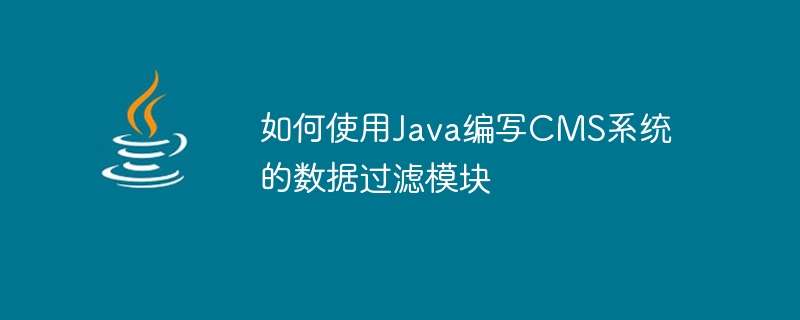

How to use Java to write the data filtering module of the CMS system
In the modern information age, Content Management System (CMS) is widely used in various A variety of websites and applications are under development. In a CMS system, the data filtering module is a very critical component. It is responsible for effectively filtering and verifying the input data to ensure the security and legality of the data. This article will introduce how to use Java to write the data filtering module of the CMS system and provide corresponding code examples.
First of all, we need to determine the basic functions and requirements of the filtering module. In a CMS system, the main task of the data filtering module is to filter and verify user-entered data to prevent malicious attacks and illegal input. Common requirements include the following aspects:
The following is a simple Java code example that shows how to implement a basic data filtering module:
import java.util.regex.Matcher;
import java.util.regex.Pattern;
public class DataFilter {
public static String filterHtmlTags(String input) {
// 使用正则表达式过滤HTML标签
String regex = "<[^>]+>"; // 匹配所有的HTML标签
Pattern pattern = Pattern.compile(regex);
Matcher matcher = pattern.matcher(input);
String result = matcher.replaceAll(""); // 替换所有的HTML标签为空字符串
return result;
}
public static String filterSpecialChars(String input) {
// 使用正则表达式过滤特殊字符
String regex = "[\n\r]"; // 匹配换行符和回车符
Pattern pattern = Pattern.compile(regex);
Matcher matcher = pattern.matcher(input);
String result = matcher.replaceAll(""); // 替换所有的换行符和回车符为空字符串
return result;
}
public static String filterSensitiveWords(String input) {
// 过滤敏感词汇
String[] sensitiveWords = {"敏感词1", "敏感词2", "敏感词3"}; // 敏感词汇列表
for (String word : sensitiveWords) {
input = input.replaceAll(word, "***"); // 替换敏感词汇为星号
}
return input;
}
public static void main(String[] args) {
String input = "<p>这是一段带有HTML标签的文本。
有些敏感词汇需要过滤。</p>";
String filteredInput = filterHtmlTags(input);
System.out.println(filteredInput); // 输出:这是一段带有HTML标签的文本。有些敏感词汇需要过滤。
filteredInput = filterSpecialChars(input);
System.out.println(filteredInput); // 输出:<p>这是一段带有HTML标签的文本。有些敏感词汇需要过滤。</p>
filteredInput = filterSensitiveWords(input);
System.out.println(filteredInput); // 输出:<p>这是一段带有HTML标签的文本。
有些***需要过滤。</p>
}
}In the above code example, we use Java’s regular expressions ( regex) to filter HTML tags and special characters, and use the replaceAll() method of strings to replace sensitive words with asterisks. By calling different filtering methods, we can filter and verify the input data according to actual needs to ensure the security and legality of the data.
It should be noted that the above example is just a simple demonstration and does not take into account all possible situations. In practical applications, we need to design and implement a more complete and reliable data filtering module based on specific business needs and system security requirements, combined with other strategies and tools.
To sum up, the data filtering module plays a vital role in the CMS system. By using the data filtering module written in Java, we can effectively filter and verify user-entered data to ensure the security and legality of the data, thereby improving system security and user experience. We hope that the code examples provided in this article will be helpful to readers in understanding and implementing the data filtering module of the CMS system.
The above is the detailed content of How to use Java to write the data filtering module of CMS system. For more information, please follow other related articles on the PHP Chinese website!
